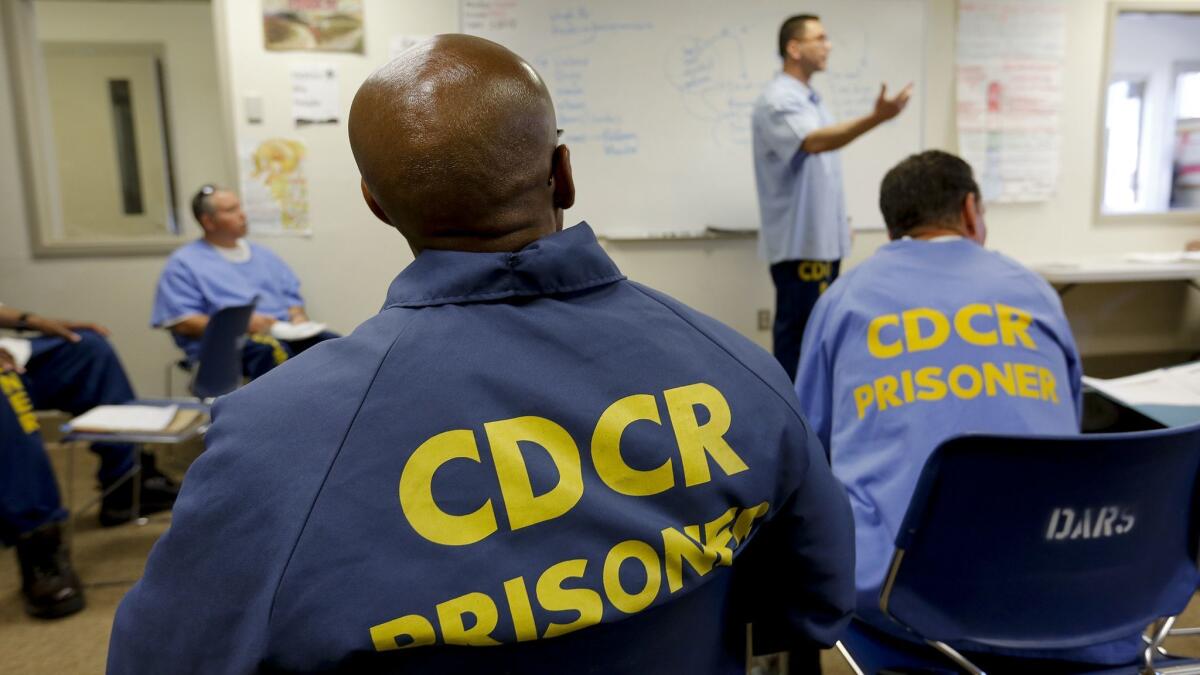Despite an emphasis on inmate rehab, California recidivism rate is ‘stubbornly high’

- Share via
Reporting from Sacramento — California set ambitious new goals in 2012 to help state inmates transition into society and infused the Department of Corrections and Rehabilitation with more funding to fulfill the mandate. But a state audit released Thursday found corrections officials have failed to connect many prisoners with services, monitor rehabilitation programs and keep people away from incarceration.
State auditors said poor administrative practices resulted in 62% of 24,000 inmates leaving state prisons without having those needs met in fiscal year 2017. And recidivism, the rate at which people commit a subsequent crime within three years out of custody, has remained “stubbornly high,” according to the audit — averaging 50% over the past decade — even as the state inmate population has dropped.
Cognitive behavioral therapy programs have been developed to correct an inmate’s patterns of thinking and behavior, and can include classes on substance abuse, anger management and family relationships. Inmates in those programs “recidivated at about the same rate as inmates who did not complete the programs,” State Auditor Elaine Howle wrote in the report. “These results are serious enough to highlight an urgent need for corrections to take a more active and meaningful role in ensuring that these programs are effective.”
The analysis began with data from fiscal year 2014 and tracked inmates over several years, a time period that corrections officials said predated the significant expansion of programs.
Vicky Waters, a corrections spokeswoman, said the department is taking the auditor’s findings seriously and has been working to implement most of the recommendations, which include addressing longstanding staff vacancies and evaluating existing mechanisms to analyze offenders’ needs.
“The department is committed to building a strong model to measure our rehabilitative programs consistently and to continue enhancing public safety by ensuring our inmates have the skills and resources they need for a successful transition back to their communities,” Waters said in a written statement.
But the audit, requested by Assemblyman Reggie Jones-Sawyer (D-Los Angeles), has raised concerns among state lawmakers and criminal justice reform groups that over the last two decades have worked to shift the focus of state corrections toward rehabilitation. Jones-Sawyer, chairman of the Assembly Public Safety Committee, said he and other lawmakers are discussing ways legislative committees could provide better oversight moving forward and want to bring in outside academic experts to improve failing programs.
Not all of the audit’s results were negative, he said, pointing to findings that show some programs have been successful, particularly when coupled with community-based services for inmates upon release. He said he asked Howle to undertake the audit after hearing anecdotal concerns about the shift to rehabilitation from opponents of that move.
“I wanted some fact-based information on what was working and what wasn’t working, plus the voters of California have decided that we are going to expand money on rehabilitation,” he said. “I just want to make sure we are doing it right.”
Former Gov. Jerry Brown initiated efforts to reshape the state’s criminal justice system after a 2011 ruling by the U.S. Supreme Court upheld the release of some 46,000 state prison inmates after years of overcrowding.
In 2012, the state corrections department released a blueprint to improve conditions and increase access to rehabilitation programs. Corrections officials have since expanded cognitive behavioral therapy programs, vocational training and education to all 36 California prisons and have seen their budget for such initiatives rise from $234 million five years ago to $298 million in the fiscal year that ends in July, according to the state audit.
Under Proposition 57, which voters approved in 2016 to overhaul the state’s parole system, prisoners can now receive more credits toward their sentences for participating and completing the programs.
But state auditors said that for years corrections officials have failed to properly evaluate whether the initiatives are working. And they found a significant portion of programs’ areas of study were not based on evidence that shows they have a positive influence on offenders or can cut their chances of getting arrested once out of custody.
The state audit also found corrections officials have not appropriately placed inmates on waiting lists for some classes and have failed to match others with those that best address their needs.
“Although [the corrections department] plans to coordinate with external researchers to conduct a performance evaluation of the rehabilitation programs over the course of the next two years, [it] has taken no formal steps to initiate this process,” the report found.
Lenore Anderson, executive director for Californians for Safety and Justice, which advocates for polices to reduce the prison population and increase services for inmates, said the results were not surprising after having “multiple decades of a behemoth prison system devoid of a focus on rehabilitation.”
But they should place new urgency on that focus, she said.
“I am grateful there is this much attention to ensuring that we are reaching that goal,” she said. “It is a good thing that there is a microscope on this.… What is clear to me from this report is that we have a long way to go.”
Not all were satisfied with the findings. Members of community nonprofits said the report lacked an understanding of their work and the strides they have made to help people adjust to life outside of prison once released.
Caitlin Dunklee, a coordinator with Transformative In-Prison Workgroup, which represents 35 organizations working in state prisons, said auditors used only one marker to measure success — recidivism — without capturing broader societal failures. That an inmate might receive six months of substance abuse classes but struggle to find housing and reoffend may not be an indicator that the classes weren’t effective, she said.
“We have demonstration of our success,” she said of the advances made by the groups she represents. “But unfortunately, it wasn’t reflected in this auditor’s report.”
More stories from Jazmine Ulloa »
Follow @jazmineulloa on Twitter, sign up for our daily Essential Politics newsletter and listen to the weekly California Politics Podcast
More to Read
Get the L.A. Times Politics newsletter
Deeply reported insights into legislation, politics and policy from Sacramento, Washington and beyond. In your inbox three times per week.
You may occasionally receive promotional content from the Los Angeles Times.











